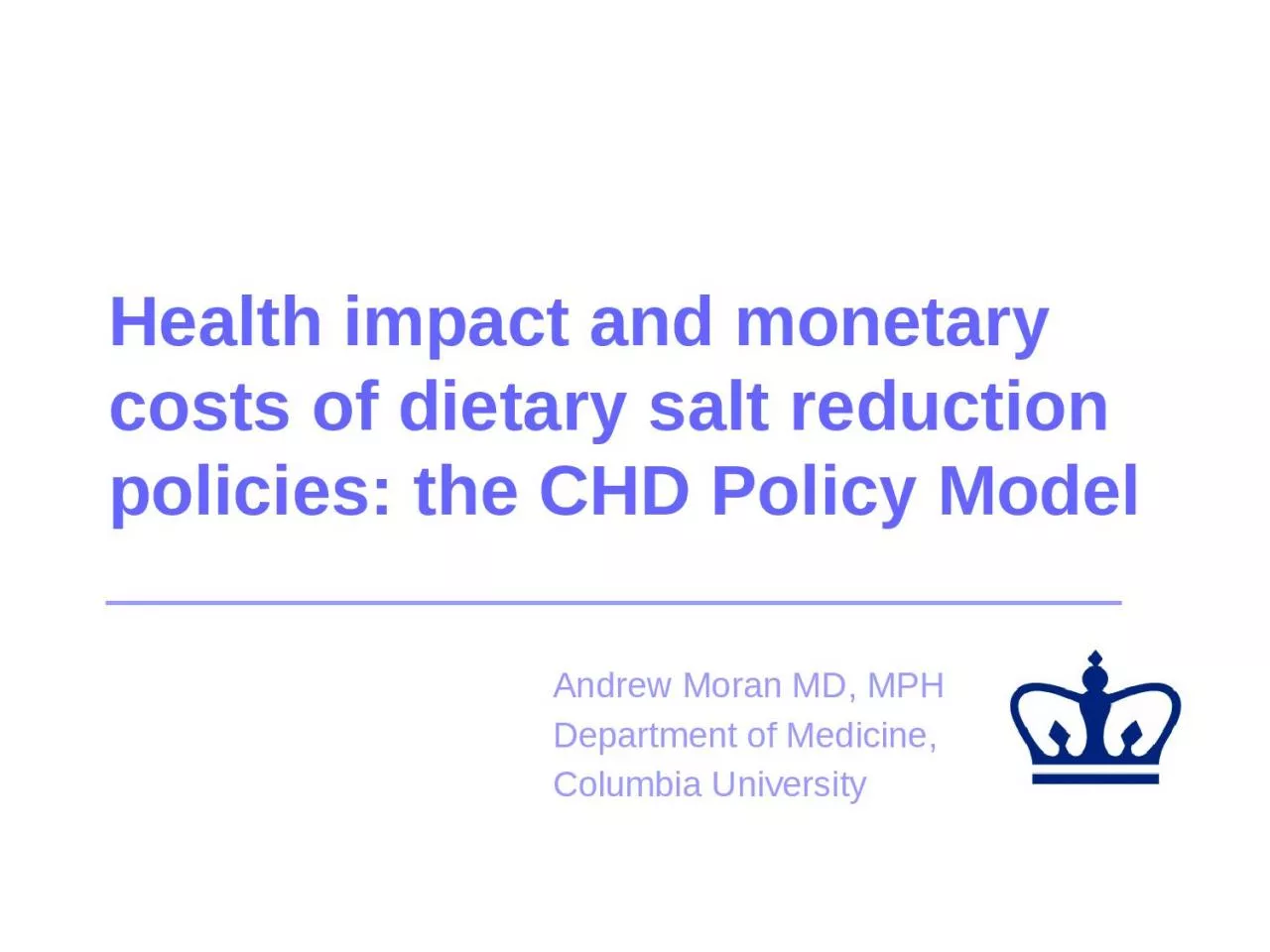

Andrew Moran MD MPH Department of Medicine Columbia University Overview What are cardiovascular disease CVD computer simulation models and what are their uses Introduction to the Coronary Heart Disease CHD Policy Model and US and Argentina versions ID: 1003062
Download Presentation The PPT/PDF document "Health impact and monetary costs of diet..." is the property of its rightful owner. Permission is granted to download and print the materials on this web site for personal, non-commercial use only, and to display it on your personal computer provided you do not modify the materials and that you retain all copyright notices contained in the materials. By downloading content from our website, you accept the terms of this agreement.
1. Health impact and monetary costs of dietary salt reduction policies: the CHD Policy ModelAndrew Moran MD, MPHDepartment of Medicine,Columbia University
2. Overview What are cardiovascular disease (CVD) computer simulation models, and what are their uses?Introduction to the Coronary Heart Disease (CHD) Policy Model and U.S. and Argentina versionsPolicy analyses: United States dietary salt policy analysisArgentina dietary salt policy analysis
3. What are CVD computer simulation models, and what are their uses?
4. What is a Markov-style computer simulation model?WellSickDeadWell0.750.200.05Sick0.000.900.10Dead0.000.001.00State transition matrix for one model cycle:
5. What are the uses of computer simulation models?Translate epidemiologic, trial, and economic data into policy researchCompare policy alternatives using a standard metricFill gaps in current knowledgeExtend results of clinical trialsForecast the future using demographic predictionsScale up epidemiologic and trial results to a larger population Addressing the limitations of computer simulation modelstransparencysensitivity analysis
6. Introduction to the CHD Policy Model
7. Simplified CVD Policy ModelWithin a yearly cycle:Incidence or event rate1 day case fatality30 day case fatality30 day CVD survivorsLong term CVD survivorsProbability of repeat CVD eventsProbability of CVD or nonCVD deathPopulation without CVDOutcomes:DeathsNonfatal CVD eventsQALYsCosts
8. CHD Policy Model StructureDEMOGRAPHIC-EPIDEMIOLOGIC MODEL Persons without CHD or stroke sorted by:Age (35-84 years)SexBlood pressureTotal or LDL chol.SmokingHDL cholesterolDiabetesBMIBRIDGE MODEL(acute stroke or CHD, first 28 days)DISEASE HISTORY MODELPersons with CHD or stroke:Age (35-84 years)SexCHD type (angina, MI, or arrest)Stroke type (ischemic or hemorrhagic)Multivariate risk functions CHD, stroke and non-cardiovascular deaths
9. CHD Policy Model: state transition probabilitiesTransition from no CVD to CVD:* Transition from chronic CVD to repeat CVD (examples):Probability of MI in stable angina patientsProbability of stroke after MIProbablity of revascularization if stable angina*similar for probabilty of nonCVD death
10. CHD Policy Model U.S. data inputsVariableSourcePopulation of the U.S.US Census BureauIncidence and case-fatality forCHD and StrokeFramingham Heart Study, National Hospital Discharge SurveyCHD, stroke, non-CVD mortality U.S. Centers for Disease ControlCVD risk factor means and distributions, year 2002U.S. National Health and Nutrition Examination Survey (NHANES)Multivariate risk for CVD events, non-CVD deathFramingham Heart StudyCHD intervention utilization and costs (hospitalization, medications, revascularization, long-term care)California Hospital Discharge Database (OSHPD) and Medical Expenditure Panel Survey (MEPS)Stroke costs (hospitalization, medications, long-term care, background costs)California Hospital Discharge Database (OSHPD) and Medical Expenditure Panel Survey (MEPS)Disability adjustment methodsBeaver Dam Study, EuroQol Survey
11. CHD Policy Model-Argentina: data inputsVariableSourcePopulation of ArgentinaUN Population DivisionIncidence and case-fatality forCHD and StrokeHospitalized MI: Caccavo et al.Hospitalized CHD and stroke: national hospital registrySAC, ReNACer and PICSIS registriesCHD, stroke, non-CVD mortality National vital statisticsMultivariate risk for CVD events, non-CVD deathFramingham Heart StudyCVD risk factor means and joint distributions, year 2006CARMELA Study, Buenos AiresNational Risk Factor (telephone) SurveyCHD intervention utilization and costs (hospitalization, medications, revascularization, long-term care)National hospital registryStroke costs (hospitalization, medications, long-term care, background costs)National hospital registryDisability adjustment methodsGlobal Burden of Disease Study
12. Model calibration
13. Model calibrationIncidenceCohort StudiesHospital registriesCase fatalitySurveillance studiesHospital registriesMortalityVital statisticsCohort studiesPrevalencePopulation surveysCohort studies
14. Model calibration
15. Model calibration
16. Dietary salt policy analyses
17. Degree of reduction in dietary salt and corresponding change in systolic blood pressure (SBP in mmHg)1 gm/day salt reduction3 gm/day salt reductionLow SBP estimateHigh SBP estimateLow SBP estimateHigh SBP estimateUS PopulationHypertensives*1.201.873.605.61Age ≥65 1.201.873.605.61All Others0.601.171.803.51Black US PopulationHypertensives*1.803.035.409.10Age ≥65 1.201.873.605.61All Others1.201.873.605.61Bibbins-Domingo, et.al, NEJM 2010.*based on systolic blood pressure ≥140 mmHg or diastolic blood pressure ≥90 mmHg or use of antihypertensive medications
18. Percent change in incident CHD with 3 gm/day reduction in dietary saltBibbins-Domingo, K. et. al. NEJM, 2010, 362 (7):590-99.
19. Comparing salt reduction to other preventive measures (deaths 2010-2019)
20. Cost and effectiveness of salt reduction and hypertension treatment annually and cumulatively from 2010-2019Cost of interventions(billions)Change in healthcare cost(billions)Change in QALYs(thousands)Cost per QALY (dollars)Healthcare cost saved per dollar spent on intervention (dollars)Population reduction in dietary salt1 gm/day*0.3-7.0 (1.4) 120 (14.6) Cost savings26.1 (5.2)3 gm/day*0.3-20.4 (4.1) 350 (42) Cost savings76.0 (15.4)Blood pressure treatment with medications among hypertensive individuals19.5 (0.07)14.2 (2.7)360 (42)15,800 (9,900)0.7 (0.1)Cumulative cost and effectiveness of gradually reducing dietary salt over the decade from 2010-20191 gm/day*2.731.6 (6.5)350 (43)Cost savings11.8 (2.4)3 gm/day*2.795.6 (19.6)1,000 (127)Cost savings35.6 (7.3)*based on high estimate for effect of salt reduction on blood pressure and US $1 per capita cost of dietary salt reduction programBibbins-Domingo, et.al, NEJM 2010
21. Projections of the effectiveness, of a 3 gram/day average reduction in dietary salt, by age and sex, Argentina 2011-2020**Ferrante et al., submitted
22. Projections of the effectiveness, costs, and cost-effectiveness of a 3 gram/day average reduction in dietary salt, Argentina 2011-2020*B: Escenario de “alto efecto ”Costo intervención ($)Costos por EC ($)Costos no por EC ($)Costo marginal ($)QALYQALY marginalCosto-efectividad incremental ($ por QALY)Situación actual03108131,8660154.694.683 Reducción de sodio142942131,063974154.956.807262124-3716B: Escenario de “bajo efecto ” Costo intervención ($)Costos por EC ($)Costos no por EC ($)Costo marginal ($)QALYQALY marginalCosto-efectividad incremental ($ por QALY)Situación actual03108131.8660154.694.683 Reducción de sodio143003131.407-569154.856.157161.474-3526EC = Enfermedad coronaria (CHD); QALY = Quality-adjusted life year; $ = US dollars in millions*Ferrante et al., submitted
23. ConclusionsIf sufficient data are available, CVD policy models can inform dietary salt lowering policy makingHowever, current estimates are based on limited data. There is a need for:Policy “natural experiments” to better quantify effectiveness (example of second hand smoking)Detailed measurement of program costs—may vary a lot across jurisdictions
24. Thank you!
25. AcknowledgementsUniversity of California, San FranciscoKirsten Bibbins-Domingo, PhD, MD, MASEliseo Perez-Stable, MD, MPHPam Coxson, PhDTekeshe Mekonnen, MSDavid Guzman, MSPHJim Lightwood, PhDMark Pletcher, MD, MPHColumbia UniversityLee Goldman, MD, MPHMinistry of Health, ArgentinaDaniel Ferrante, MDUniversity of Buenos AiresRaul Mejia, MD